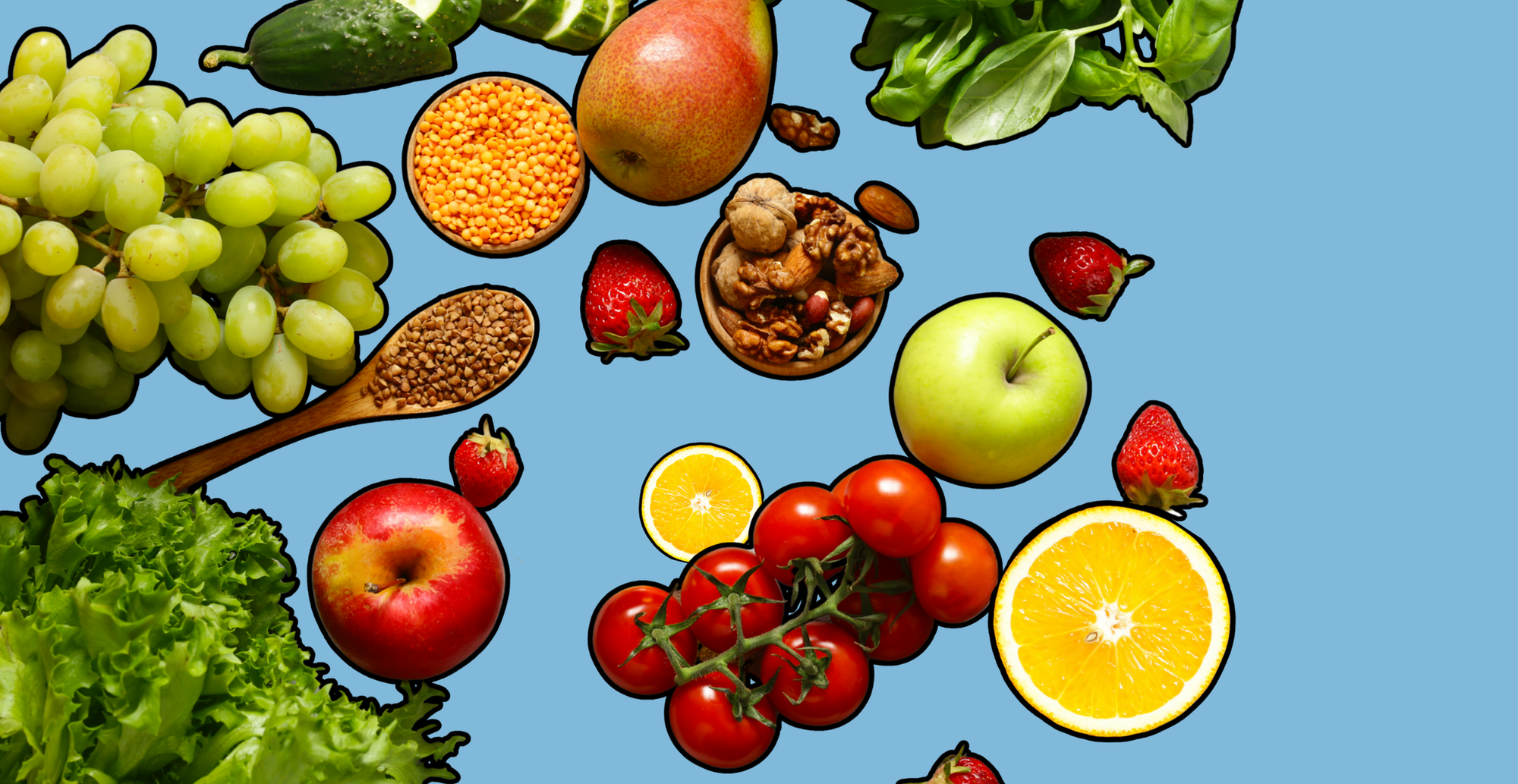

· By Olivia Silverthorne
Fibre: The underrated nutrient in a protein obsessed world
In recent years protein has become a nutritional superstar and for good reason. It supports muscle repair, keeps us feeling full, and plays a key role in everything from workouts to our energy levels.
A quick trip to the supermarket shows just how much protein has become the new health superhero, where you’ll find it used to market everything from shakes and pancakes to ready meals.
But in all the excitement, there’s one equally important nutrient that’s often left in the dust: fibre.
In this post, we’re giving fibre the spotlight it deserves, exploring why it’s essential for long-term health, how it complements protein, and why the best approach to nutrition isn’t about choosing one or the other, but balancing both.
The protein craze
There’s no denying that protein has earned its place in the spotlight. Over the past decade, it’s become the go-to nutrient for everything from fitness goals to healthy snacking. Diets like keto, paleo, and high-protein plans have all helped fuel this trend and food brands have followed suit, adding protein to everything from pastas, chocolate bars, bottled drinks and yogurts.
The buzz around protein has been largely positive, it’s helped more people understand the importance of eating enough to support muscle repair, satiety, and metabolic health. But in the rush to pack in the protein, there is a common misconception that protein is the only food group we need to be prioritising.
While protein may fuel your performance, fibre supports the systems that keep you running smoothly every day. It’s time we gave it a bit more credit.
The underrated nutritional power house
Fibre is a group of plant based carbohydrates that your body can’t fully digest.There two main types of fibre, soluble and insoluble.
Soluble fibre dissolves in water and forms a gel-like substance in your gut and is found in food such as oats, barley, apples, citrus fruits, legumes (lentils, beans), chia seeds, flaxseeds.
Insoluble fibre does not dissolve in water and passes through your digestive system mostly intact and is found in foods such as whole grains (wheat bran, brown rice), nuts and seeds, vegetables (especially the skins), cauliflower, green beans and potatoes.
Although fibre is responsible for a host of amazing process in the body, it often files under the radar. Shockingly over 90% of adults in the uk don’t actually consume enough fibre!
What’s so fab about fibre?
Lets dive into some of the amazing benefits fibre has for our body:
1. Supports gut health
Fibre is one of your guts most important alies. Certain types of fibre (like inulin, resistant starch, and FOS) act as prebiotics. This is important as prebiotics feed the beneficial bacteria in our gut, helping our gut microbiome to thrive. A balanced and diverse gut microbiome is key for maintaining good gut health, which plays a role in our digestion, mood, immunity, and even mental health.
Insoluble fibre adds bulk to your stool and helps it pass easier through your digestive tract, helping to avoid constipation. Think of insoluble fibre a bit like a natural "clean-up crew" for your intestines.
Fibre also helps to maintain a strong and intact gut barrier by nourishing the cells that line your colon. This can reduce the risk of a condition called leaky gut, where unwanted substances from the gut, pass into the bloodstream and trigger inflammation.
2. Keeps you fuller for longer
Although protein seems to get all the praise for keeping you full, fibre plays a role in this too! Fibre is a great way of adding volume of food to your plate, helping you to feel physically full.
In addition to this, soluble fibre (found in things like oats, beans, or chia seeds) forms a gel-like substance in your digestive tract. This gel like substance makes the food “heavier” and more viscous, which delays how quickly it passes into the small intestine. This means that your body digests and absorbs the meal more gradually, leading to a longer-lasting feeling of fullness and steadier energy.
3. Helps stabilise blood sugar
Fibre can also be an amazing tool for controlling blood sugar spikes. It works by soluble fibre forming that gel like substance in your gut, physically slowing down the absorption of glucose in to your blood stream. The slower absorption of glucose prevents a sharp spike and inevitable crash in blood sugar. Think of fibre as a “speed bump” for sugar entering your system.
High fibre meals also tend to have a lower glycemic index (GI). This means they cause a slower, smaller rise in blood sugar compared to low-fibre versions of the same food. For example, brown bread would have a lower GI in comparison to white bread, meaning that it would spike your blood sugar levels less, leading to much less of a ‘crash’.
4. Supports Heart Health
Fibre is a heart health superhero.
Soluble fibre binds to cholesterol particles in your digestive system, helping to carry some of that cholesterol out of the body instead of letting it be absorbed. This can lead to lower LDL cholesterol which is super important as this the kind that contributes to plaque buildup in arteries and can lead to cardiovascular disease.
A high fibre diet is also linked to lower blood pressure and reduced inflammation, both of which lower the risk of heart disease.
5. Reduces Inflammation
Fibre plays a big role in helping our bodies fight inflammation. One way it does this is by feeding the good bacteria in our gut. When these bacteria are fed, they produce something called short-chain fatty acids (SCFAs), which help calm inflammation.
Fibre also helps keep our gut microbiome balanced and supports a strong gut lining, both of which are great for our immune system and overall health. On top of that, eating plenty of fibre can help lower body weight and blood pressure, which are both linked to lower levels of inflammation too.
How much fibre should you be eating a day?
So now you know just how amazing fibre is, how much should you be eating a day?
In the UK the RNI (reference nutrient intake) for fibre is 30g a day for adults, although Most adults in the UK currently consume far less than this (the average intake is around 18–20g/day).
Although 30 grams may seem like a lot, once you know what foods are packed with fibre- reaching 30g can be super simple!
Here’s a list of some foods which are great sources of fibre and how much fibre they provide:
- Chia seeds – 25g (about 2 tablespoons): 10g fibre
- Lentils (cooked) – 200g: 15.6g fibre
- Black beans (cooked) – 200g: 15g fibre
- Oats (dry) – 40g: 4g fibre
- Whole wheat spaghetti (cooked) – 140g: 6g fibre
- Quinoa (cooked) – 185g: 5g fibre
- Avocado – 1 medium (about 150g): 10g fibre
- Pear (with skin) – 1 medium (about 180g): 5.5g fibre
- Apple (with skin) – 1 medium (about 182g): 4.4g fibre
- Broccoli (cooked) – 150g: 5g fibre
- Carrots (raw) – 130g: 3.5g fibre
- Sweet potato (with skin) – 1 medium (about 150g): 4g fibre
- Almonds – 30g (about 23 almonds): 3.5g fibre
- Flaxseeds (ground) – 10g (about 1 tablespoon): 2.8g fibre
- Raspberries – 125g: 8g fibre
Fibre rich meals you can try at home
Tofu Stir-Fry with Brown Rice & Mixed Veg
- Key ingredients: Tofu, broccoli, edamame, carrots, peppers
- Serve with: Brown rice or buckwheat noodles
- Approx. 8–12g fibre per serving
Overnight Oats with Chia & Berries
- Key ingredients: Rolled oats, chia seeds, ground flaxseed, almond milk, raspberries or blueberries
- Optional toppings: Nut butter, sliced banana, sunflower seeds
- Approx. 10–12g fibre per bowl
Stuffed Sweet Potatoes
- Key ingredients: Baked sweet potatoes, black beans, sweetcorn, avocado, red pepper
- Top with: Salsa and Greek yogurt or tahini
- Approx. 12–15g fibre per serving
Lentil & Veggie Curry
- Key ingredients: Red lentils, chickpeas, spinach, carrots, onions, tomatoes
- Serve with: Brown rice or quinoa
- Fibre boost: Add a tablespoon of flaxseed or serve with wholemeal chapatis
- Approx. 15–20g fibre per serving
Why Balance Beats Buzzwords
It’s important to remember that no single nutrient should be treated as a trend or a quick fix. Protein and fibre both play essential roles in our health so it’s not about choosing one over the other, but about creating balance. Instead of fixating on one "hero" ingredient, aim for meals that include a variety of nutrients. Think of your plate as a team effort: a good source of protein, plenty of fibre-rich whole foods like vegetables, legumes, and whole grains, and healthy fats to round it out. When we shift the focus from hype to nourishment, that’s where real, sustainable health begins.
